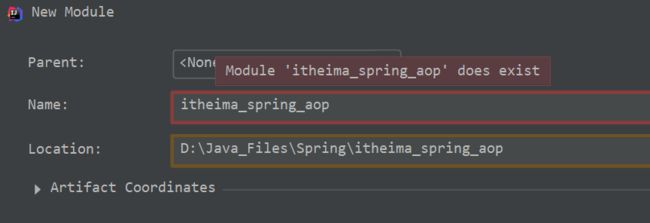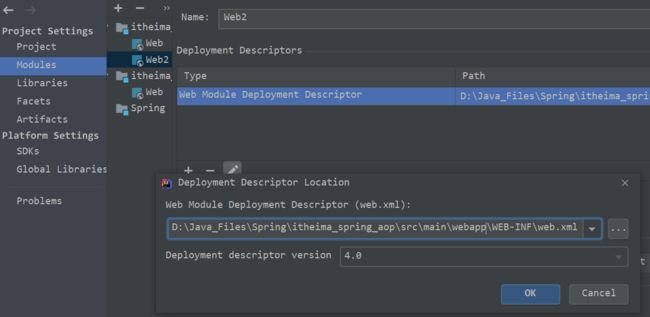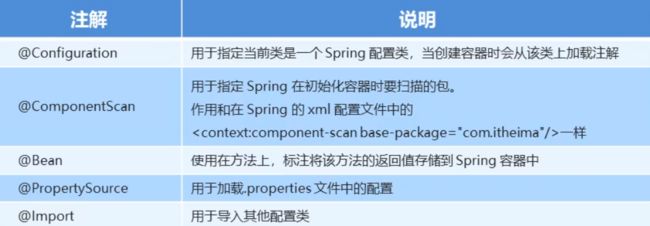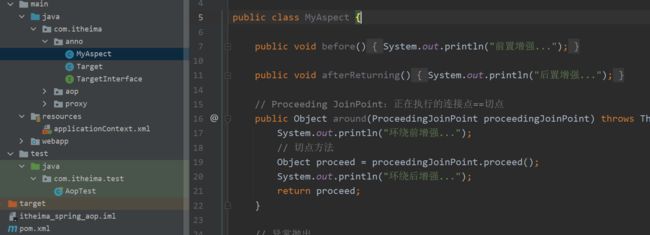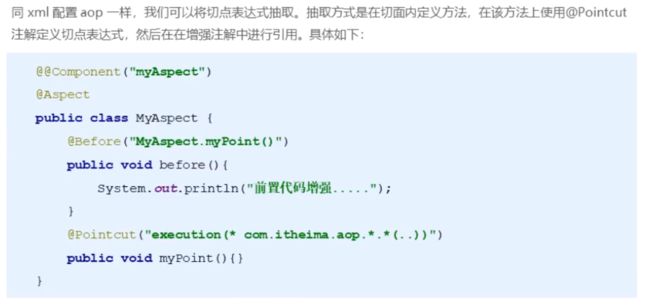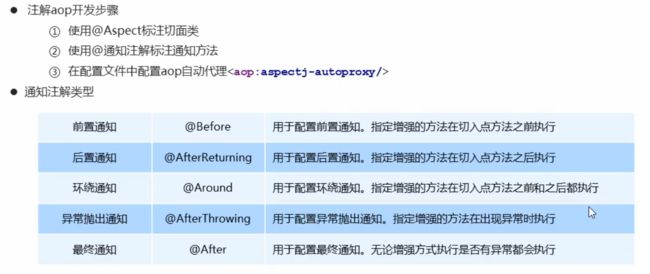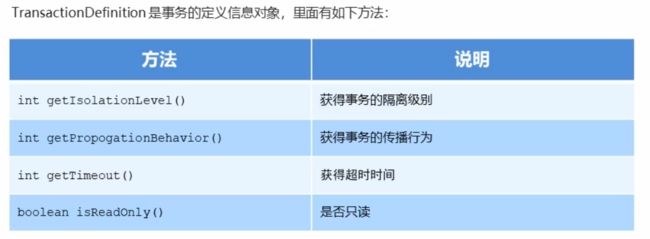【Java】Spring框架
一、Spring简介
简介
Spring是分层的Java SE/EE应用full-stack轻量级开源框架,以IoC(Inverse Of Control:反转控制)和AOP(Aspect Oriented Programming:面向切面编程)为内核。提供了展现层SpringMVC和持久层Spring JDBCTemplate以及业务层事务管理等众多的企业级应用技术,还能整合开源世界众多著名的第三方框架和类库,逐渐成为使用最多的Java EE企业应用开源框架。
现在,2017年9月发布了最新的Spring版本——Spring 5.0通用版(GA)
优势
- 方便解耦,简化开发
- 通过Spring提供的IoC容器,可以将对象间的依赖关系交由Spring进行控制,避免硬编码所造成的过度耦合。
- 用户也不必再为单例模式类、属性文件解析等这些很底层的需求编写代码,可以便专注于上层的应用
- AOP编程的支持
- 通过Spring的AOP功能,方便进行面向切面编程,许多不容易用传统OOP实现的功能可以通过AOP轻松实现。
- 声明式事务的支持
- 可以将我们从单调烦闷的事务管理代码中解脱出来,通过声明式方式灵活的进行事务管理,提高开发效率和质量。
- 方便程序的测试
- 可以用非容器依赖的编程方式进行几乎所有的测试工作,测试不再是昂贵的操作,而是随手可做的事情。
- 方便集成各种优秀框架
- Spring对各种优秀框架(Struts、 Hibemate、 Hessian、 Quartz等)的支持。
- 降低JavaEE API的使用难度
- Spring对JavaEE API (如JDBC、JavaMail、 远程调用等)进行了薄薄的封装层,使这些API的使用难度大为降低。
- Java源码是经典学习范例
- Spring的源代码设计精妙、结构清晰、匠心独用,处处体现着大师对Java设计模式灵活运用以及对Java技术的高深造诣。它的源代码无疑是Java技术的最佳实践的范例。
二、Spring体系结构
其中,核心容器最为关键,SpEL——Spring Expression Language(spring表达式语言),Beans——对象,Core——核心,Context——上下文。
Spring程序开发步骤
①导入 Spring 开发的基本包坐标
②编写 Dao 接口和实现类
③创建 Spring 核心配置文件
④在 Spring 配置文件中配置 UserDaoImpl
⑤使用 Spring 的 API 获得 Bean 实例
Spring项目(Maven)的创建
①首先在idea的工作空间workspace文件夹下创建一个名为Spring的文件夹
②在idea中选择文件,打开File,选择刚刚创建的文件夹Spring,打开
③在Idea中的操作:点击刚刚的Spring,之后点击新建一个Module,选择Maven之后点击Next
④选择设定的Module名称为itheima_spring_aop(Name),之后选择Finish完成创建。之后以相同的方式创建itheima_spring_ioc项目。
⑤选择刚刚创建的aop项目,选择Project Structure,配置好jdk并选择下面的文件夹为刚刚创建的aop项目文件夹。
⑥之后选择下面的Facets选项,点击+号,选择web项目,添加
⑦在下一个界面修改上下两个选项的文件路径名,并修改为一般惯用的路径文件
D:\Java_Files\Spring\itheima_spring_aop\src\main\webapp\WEB-INF\web.xml
D:\Java_Files\Spring\itheima_spring_aop\src\main\webapp
⑧从第三步开始,以相同的方式创建itheima_spring_iocModule。至此,项目创建完成。
Spring工程实际运用
①导入坐标
②创建Bean
③创建applicationContext.xml文件
④在配置文件中进行配置
⑤创建ApplicationContext对象getBean
实际操作:
一、打开Module下面的pom.xml文件,添加Spring
添加的部分代码如下:
<dependencies>
<dependency>
<groupId>org.springframeworkgroupId>
<artifactId>spring-contextartifactId>
<version>5.0.5.RELEASEversion>
dependency>
dependencies>
二、在需要的路径创建一个接口,并为该接口提供实现
三、在resources文件夹下创建applicationContext.xml配置文件(该名字可以自己定义)
四、配置applicationContext.xml配置文件,在Beans中添加Bean对象,设置自定义一个id(名字可自定义,但是后续需要使用),并且需要用到之前接口的实现类的文件名(class="com.itheima.dao.impl.UserDaoImpl"),具体配置如图
五、在Java目录下创建一个新的Module,创建一个新的class文件。本class文件就是真正用到spring的Java文件,我这里根据课程创建的,一样是demo->UserDaoDemo
此class中的代码部分,configLocation参数就是刚才编写的配置文件名(不用写路径,之后自己会根据寻找文件)。UserDao类的实例对象后的getBean()方法的参数就是之前配置文件中的id。
至此为止,简单工程的实际创建使用暂时结束。
最终创建成功自己简单运行的结果:
在此次使用过程中,一共使用了五个文件。两个配置文件:
pom.xml // 配置Spring详细参数
applicationContext.xml //配置使用Bean对象
一个接口文件,两个class文件,分别对应接口的实现方法以及客户端代码对于接口方法的获取调用(使用Spring的过程)。
三、Spring配置文件详解
在Spring项目中,上述的项目中存在两个配置文件,其中有一个为创建Spring项目时生成的pom.xml,该文件的作用是用来导入Spring框架的。另外一个则是涉及到Spring项目的使用,该配置文件需要用户自己来创建使用。需要在Beans中创建新的Bean对象,设置ID属性以及class属性来获取对象。
<bean id="userDao" class="com.itheima.dao.impl.UserDaoImpl">bean>
此时,该行代码使用的id需要在这整个xml文件中唯一,是标识确认,不能和其他的Bean对象的id重复(类比于前端),后面的class是全限定名。默认的反射是通过无参构造创建对象的,这样配置需要保证UserDaoImpl中存在无参构造,如果没有无参构造则不能创建成功。
id:Bean实例在Spring容器中的唯一标识
class:Bean的全限定名
Bean标签范围配置
默认在xml配置文件中不写scope,缺省值是singleton。表示在创建Bean对象时,只会有一例出现在Spring中;而设置prototype时,则根据创建的数量,会有相应的数量的Bean对象存在于Spring中。
测试方法:创建多个UserDao对象实例,打印输出多个UserDao的地址,看看是否不同的实例会不会输出相同的地址值。
<bean id="userDao" class="com.itheima.dao.impl.UserDaoImpl" scope="singleton">bean>
作用范围、创建时机以及生存周期
- 当 scope 的取值为
singleton时,单例- Bean 的实例化个数: 1 个
- Bean 的实例化时机:当 Spring 核心文件被加载时,实例化配置的 Bean 实例
- 对象创建:当应用加载,创建容器时,对象就被创建了
- 对象运行:只要容器在,对象一直活着
- 对象销毁:当应用卸载,销毁容器时,对象就被销毁了
- 当 scope 的取值为
prototype时- Bean 的实例化个数:多个
- Bean的实例化时机:当调用
getBean()方法时实例化 Bean - 对象创建:当使用对象时,创建新的对象实例
- 对象运行:只要对象在使用中,就一直活着
- 对象销毁:当对象长时间不用时,可能会被 Java 的垃圾回收器回收
init-method:指定类中的初始化方法名称
destroy-method:指定类中的销毁方法名称
Bean实例化的三种方式
无参构造方法实例化
工厂静态方法实例化
工厂实例方法实例化
工厂静态方法实例化
①创建静态工厂类
之后跳转到之前的applicationContext.xml中,修改之前的Bean实例化语句为
<bean id="userDao" class="com.itheima.factory.StaticFactory" factory-method="getUserDao">bean>
如果方法内部不为静态的(工厂实例方法),则需要先获取工厂的Bean对象,之后再获取工厂的Bean方法。
工厂实例方法实例化
①创建一个DynamicFactory的对象,代码方法的区别就是 static 的有无
②修改xml文件配置参数
<bean id="factory" class="com.itheima.factory.DynamicFactory">bean>
<bean id="userDao" factory-bean="factory" factory-method="getUserDao">bean>
SpringBean的依赖注入分析
Bean的依赖注入概念
依赖注入(Dependency Injection):是 Spring 框架核心 IoC 的具体实现。
在编写程序时,通过控制反转,把对象的创建交给了 Spring ,但是代码中不可能出现没有依赖的情况。
IoC 解耦只是降低他们的依赖关系,但不会消除。例如:业务层仍会调用持久层的方法。这种业务层和持久层的依赖关系,在使用 Spring 之后,就让 Spring 来维护了。
简单的说,就是坐等框架把持久层对象传入业务层,而不用我们自己去获取。
在上述的应用实例中,将 UserDao 注入到 UserService 中的方法有两个:构造方法、set 方法
Bean的依赖注入的数据类型
注入数据的三种类型
普通数据类型
引用数据类型
集合数据类型
普通数据类型和引用数据类型的注入
在实现类中写setter方法
public class UserDaoImpl implements UserDao {
private String userName;
private int age;
public void setUserName(String userName) {
this.userName = userName;
}
public void setAge(int age) {
this.age = age;
}
@Override
public void save() {
System.out.println(userName + "=====" + age);
System.out.println("save running...");
}
}
因为是普通数据和引用数据类型,我们直接使用value对这两个变量进行赋值。
<bean id="userDao" class="com.itheima.dao.impl.UserDaoImpl">
<property name="userName" value="zhangsan">property>
<property name="age" value="20">property>
bean>
最终运行效果:
集合数据类型的注入
针对集合类型,我们选取Map以及List集合。
List集合的配置文件
<bean id="userDao" class="com.itheima.dao.impl.UserDaoImpl">
<property name="strList">
<list>
<value>aaavalue>
<value>bbbvalue>
<value>cccvalue>
list>
property>
bean>
具体步骤还是和之前的普通类型数据的步骤类似。在实现类中添加相关参数的setter方法,之后再save方法中添加打印输出。
private List<String> strList;
private Map<String, User> userMap;
private Properties properties;
public void setStrList(List<String> strList) {
this.strList = strList;
}
public void setUserMap(Map<String, User> userMap) {
this.userMap = userMap;
}
public void setProperties(Properties properties) {
this.properties = properties;
}
@Override
public void save() {
System.out.println(strList);
System.out.println(userMap);
System.out.println(properties);
System.out.println("save running...");
}
运行结果正常,输出[aaa, bbb, ccc]。
Map集合的配置文件
针对Map集合数据类型,Map实际上属于一种键值对,并非单纯的集合类型,所以不同于List集合。
package com.itheima.domain;
public class User {
private String name;
private String addr;
public void setName(String name) {
this.name = name;
}
public void setAddr(String addr) {
this.addr = addr;
}
public String getName() {
return name;
}
public String getAddr() {
return addr;
}
@Override
public String toString() {
return "User{" +
"name='" + name + '\'' +
", addr='" + addr + '\'' +
'}';
}
}
编写完上述的集合之后,开始对配置文件进行编写
<bean id="userDao" class="com.itheima.dao.impl.UserDaoImpl">
<property name="strList">
<list>
<value>aaavalue>
<value>bbbvalue>
<value>cccvalue>
list>
property>
<property name="userMap">
<map>
<entry key="u1" value-ref="user1"/>
map>
property>
<property name="properties">
<props>
<prop key="p1">properties1prop>
<prop key="p2">properties2prop>
props>
property>
bean>
<bean id="user1" class="com.itheima.domain.User">
<property name="name" value="tom"/>
<property name="addr" value="beijing"/>
bean>
<bean id="userService" class="com.itheima.service.impl.UserServiceImpl"/>
这次的配置不同于在bean中直接添加list的value值,需要添加新的bean对象,并且在新的bean中添加新的property,在property中添加新的value,这次的name与之前的User类中的name和addr相对应,使得键值的两个属性值能够对应上。
需要注意的是,value-ref的值和下面的bean中的id需要保持一致,而entry中的key则没有要求。
运行之后的值为
[aaa, bbb, ccc]
{u1=User{name=‘tom’, addr=‘beijing’}}
{p1=properties1, p2=properties2}
save running…
properties配置文件
properties1
properties2
配置方法与List集合类似。
Spring引用其他配置文件
因为项目大小的问题,我们通常将Spring项目拆分,引入其他配置文件。将部分配置拆分到其他配置文件中,而在Spring主配置文件中通过import标签进行加载,这种方法通常就是分模块开发。
<import resource = "applicationContext-xxx.xml"/>
知识要点总结
标签:
id 属性:在容器中 Bean 实例的唯一标识,不允许重复
class 属性:要实例化的 Bean 的全限定名
scope 属性:Bean 的作用范围,常用是 singleton (默认) 和 prototype
标签:属性注入
name 属性:属性名称
value 属性:注入的普通属性值
ref 属性:注入的对象引用值
标签
四、Spring相关API
ApplicationContext的继承体系
applicationContext:接口类型,代表应用上下文,可以通过其实例获得Spring容器中的Bean对象。
ApplicationContext的实现类
ClassPathXmlApplicationContext
从类的根路径下加载配置文件
FileSystemXmlApplicationContext
从磁盘路径上加载配置文件,配置文件可以在磁盘的任意位置
AnnotationConfigApplicationContext
当使用注解配置容器对象时,需要使用此类来创建Spring容器,它用来读取注解
getBean()方法使用
在之前的代码中,使用UserService类getBean()方法。一共有两种方式,一种是通过id方式,一种是通过类对象方式。
public class UserController {
public static void main(String[] args) {
ApplicationContext app = new ClassPathXmlApplicationContext("applicationContext.xml");
// UserService userService = (UserService) app.getBean("userService");
UserService userService = app.getBean(UserService.class);
userService.save();
}
}
但是当容器中存在某一类的多个对象时,需要用id来获取,因为用类来获取会导致无法分清到底使用哪一个。
Spring的重点API
ApplicationContext app = new ClassPathXmlApplicationContext("applicationContext.xml");
app.getBean("id");
app.getBean(Class);
五、Spring配置数据源
数据源(连接池)的使用
- 数据源(连接池)是为了提高程序性能出现的
- 事先实例化数据源,初始化部分连接资源
- 使用连接资源时从数据源中获取
- 使用完毕后将连接资源归还给数据源
常见的数据源(连接池)有:DBCP、C3P0、Druid、BoneCP等。
数据源开发步骤
第一步:在pom.xml中添加依赖
<dependencies>
<dependency>
<groupId>mysqlgroupId>
<artifactId>mysql-connector-javaartifactId>
<version>5.1.32version>
dependency>
<dependency>
<groupId>c3p0groupId>
<artifactId>c3p0artifactId>
<version>0.9.1.2version>
dependency>
<dependency>
<groupId>com.alibabagroupId>
<artifactId>druidartifactId>
<version>1.1.10version>
dependency>
<dependency>
<groupId>junitgroupId>
<artifactId>junitartifactId>
<version>3.8.2version>
<scope>testscope>
dependency>
<dependency>
<groupId>junitgroupId>
<artifactId>junitartifactId>
<version>RELEASEversion>
<scope>testscope>
dependency>
dependencies>
其中,添加的依赖有mysql、druid、c3p0等。
第二步:创建DataSourceTest类进行测试,两者的使用都是相似的步骤。设置好对应的四个参数,之后直接连接即可。
public class DataSourceTest {
@Test
// 测试手动创建 c3p0 数据源
public void test1() throws Exception {
ComboPooledDataSource dataSource = new ComboPooledDataSource();
dataSource.setDriverClass("com.mysql.jdbc.Driver");
dataSource.setJdbcUrl("jdbc:mysql://localhost:3306/test");
dataSource.setUser("root");
dataSource.setPassword("123456");
Connection connection = dataSource.getConnection();
System.out.println(connection);
connection.close();
}
@Test
// 测试手动创建 druid 数据源
public void test2() throws Exception {
DruidDataSource dataSource = new DruidDataSource();
dataSource.setDriverClassName("com.mysql.jdbc.Driver");
dataSource.setUrl("jdbc:mysql://localhost:3306/test");
dataSource.setUsername("root");
dataSource.setPassword("123456");
Connection connection = dataSource.getConnection();
System.out.println(connection);
connection.close();
}
}
但是,这样的操作存在耦合性较高的弊端,不利于后期的修改更新操作。因此我们需要用到抽取配置文件的方式解耦合。
抽取properties配置文件
第一步:编写配置文件。新建file-> jdbc.properties。
jdbc.driver=com.mysql.jdbc.Driver
jdbc.url=jdbc:myql://localhost:3306/test
jdbc.username=root
jdbc.password=123456
第二步:使用配置文件获取到相关的参数,完成解耦合的操作。
@Test
// 测试手动创建 c3p0 数据源(加载properties配置文件形式)
public void test3() throws Exception {
// 读取配置文件
ResourceBundle rb = ResourceBundle.getBundle("jdbc");
String driver = rb.getString("jdbc.driver");
String url = rb.getString("jdbc.url");
String username = rb.getString("jdbc.username");
String password = rb.getString("jdbc.password");
ComboPooledDataSource dataSource = new ComboPooledDataSource();
dataSource.setDriverClass(driver);
dataSource.setJdbcUrl(url);
dataSource.setUser(username);
dataSource.setPassword(password);
Connection connection = dataSource.getConnection();
System.out.println(connection);
connection.close();
}
整体的使用步骤多了一步:从配置文件中抽取到相关参数。之后的使用中根据抽取到的参数set相关的使用参数即可。
需要注意的是用到ResourceBundle类中的getBundle方法,获取到之前创建的jdbc.properties配置文件。这里的使用方法是根据配置文件名字自动找寻到配置文件的所在,完成资源绑定。之后创建String对象,获得配置文件中的具体内容。
Spring配置数据源
可以将DataSource的创建权交给Spring容器去完成。
步骤总结:①在pom.xml中引入Spring容器。
<dependency>
<groupId>org.springframeworkgroupId>
<artifactId>spring-contextartifactId>
<version>5.0.5.RELEASEversion>
dependency>
②新建applicationContext.xml配置文件,在applicationContext.xml文件中添加bean对象
<bean id="dataSource" class="com.mchange.v2.c3p0.ComboPooledDataSource">
<property name="driverClass" value="com.mysql.jdbc.Driver">property>
<property name="jdbcUrl" value="jdbc:mysql://localhost:3306/test">property>
<property name="user" value="root">property>
<property name="password" value="123456">property>
bean>
注意:此处的name应该跟从之前的c3p0数据源的四种参数,将下列的setDriverClass的四种方法,去掉之前的set,并将首字母改成小写添加进去。由于是普通数据类型,直接使用value赋值即可,不需要采用引用。
ComboPooledDataSource dataSource = new ComboPooledDataSource();
dataSource.setDriverClass(driver);
dataSource.setJdbcUrl(url);
dataSource.setUser(username);
dataSource.setPassword(password);
③在java类中添加相关的程序代码
@Test
// 测试 Spring 容器创建产生数据源
public void test4() throws Exception {
ApplicationContext app = new ClassPathXmlApplicationContext("applicationContext.xml");
DataSource dataSource = app.getBean(DataSource.class);
Connection connection = dataSource.getConnection();
System.out.println(connection);
connection.close();
}
注意:这种通过.class方法getBean只适用于applicationContext.xml配置文件只有一个数据源bean的情况;若有多个,应该通过id获取到相关的Bean对象。
使用Spring加载的方式抽取jdbc配置文件
目的是使用applicationContext.xml抽取jdbc.properties配置文件信息。
步骤:①首先引入context命名空间
<beans xmlns="http://www.springframework.org/schema/beans"
xmlns:xsi="http://www.w3.org/2001/XMLSchema-instance"
xmlns:context="http://www.springframework.org/schema/context"
xsi:schemaLocation=
"http://www.springframework.org/schema/beans http://www.springframework.org/schema/beans/spring-beans.xsd
http://www.springframework.org/schema/context http://www.springframework.org/schema/context/spring-context.xsd">
bean>
将第一行复制,之后添加:context,将其中beans的部分修改为context。网站部分也一样复制修改,前后两个部分beans的内容修改为context。
②导入properties配置文件信息
<context:property-placeholder location="classpath:jdbc.properties">context:property-placeholder>
③值修改为value="${key}"的形式。
<bean id="dataSource" class="com.mchange.v2.c3p0.ComboPooledDataSource">
<property name="driverClass" value="${jdbc.driver}">property>
<property name="jdbcUrl" value="${jdbc.url}">property>
<property name="user" value="${jdbc.username}">property>
<property name="password" value="${jdbc.password}">property>
bean>
六、Spring注解开发
Spring是轻代码而重配置的开发框架,配置比较繁重,影响开发效率,所以注解开发是一种趋势。注解代替xml配置文件可以简化配置,提高开发效率。
Spring原始注解
Spring原始注解主要是替代标签的配置
完善测试环境
在注解之前,我们先惯例操作,搭建一个可以用来测试使用的Spring项目。
①首先创建接口和响应的实现
dao层的接口以及实现:
public interface UserDao {
public void save();
}
public class UserDaoImpl implements UserDao {
@Override
public void save() {
System.out.println("save running...");
}
}
service层的接口以及实现:
public interface UserService {
public void save();
}
public class UserServiceImpl implements UserService {
private UserDao userDao;
public void setUserDao(UserDao userDao) {
this.userDao = userDao;
}
@Override
public void save() {
userDao.save();
}
}
因为我们在dao层已经创建了save方法,在service层要通过set方法直接调用save方法,实现用Spring生成Bean对象直接调用的目的。
<bean id="userDao" class="com.itheima.dao.impl.UserDaoImpl">bean>
<bean id="userService" class="com.itheima.service.impl.UserServiceImpl">
<property name="userDao" ref="userDao">property>
bean>
之后,我们建立一个测试用的web层,我们使用C/S方法,直接在web层中启动整个程序。创建一个web.UserController。
public class UserController {
public static void main(String[] args) {
ApplicationContext app = new ClassPathXmlApplicationContext("applicationContext.xml");
UserService userService = app.getBean(UserService.class);
userService.save();
}
}
运行结果测试正常,能够通过Service层调用到dao层的save方法。
3月 30, 2021 3:37:22 下午 com.mchange.v2.c3p0.C3P0Registry banner
信息: Initializing c3p0-0.9.1.2 [built 21-May-2007 15:04:56; debug? true; trace: 10]
save running…
原始注解入门操作
使用注解开发,需要在applicationContext.xml配置文件中配置组件扫描,作用是指定哪一个包及其子包下的Bean需要进行扫描以便识别使用注解配置的类、字段和方法。
注解开发步骤:①需要在创建Bean的类上加上注解Component
////以上这两个代码的注解相当于在Spring配置文件中的部分——对应的是注释部分的内容。Component注解都是添加在接口对应的实现类前面,至于要在userService中获取到userDao的引用对象值,则需要在类的内部所需要获取到的属性上方使用@Autowired以及@Qualifier(“id”)获取。
值得注意的是:当使用的是xml配置的方式获取到Bean对象时,需要使用到实现类中的set方法;如果用到的时注解的方式,则可以不适用set方法。
②配置组件扫描
<context:component-scan base-package="com.itheima"/>
配置组件扫描,让Spring寻找对应的包及其子包下的注解部分。
利用这种注解,就能完成Spring的注解开发。如果没有加上组件扫描部分,会出现NoSuchBeanDefinitionException的异常。
原始注解详解
针对上述的案例,如果注解中只写了Autowired,不写Qualifier,也能实现注入。
@Repository("userDao")
public class UserDaoImpl implements UserDao {
@Override
public void save() {
System.out.println("save running...");
}
}
@Autowired // 按照数据类型从Spring容器中进行匹配
// @Qualifier("userDao") // 按照id的值从Spring容器中进行匹配的,但是要结合@Autowired一起使用
private UserDao userDao;
上述这样的情况下也能实现注入。或者直接Autowired与Qualifier均不使用,我们使用@Resource(name=“userDao”)的方式也能成功进行注入并使用。
// 此外,还可以通过注解的方式对普通的变量进行赋值
@Value("itcast")
private String driver;
System.out.println(driver);
这样的情况是可以正常打印输出itcast的。但是这样的单纯赋值意义不大,搭配properties配置文件来使用的时候用处更加广泛。
@Value("${jdbc.driver}")
private String driver;
此外,还能使用@Scope("singleton")注解来对Bean的单例或者多例进行规定。
@PostConstruct
public void init() {
System.out.println("Service对象的初始化方法");
}
@PreDestroy
public void destroy() {
System.out.println("Service对象的销毁方法");
}
但是,单纯的使用这两种注解,只会打印init方法,并不会打印destroy方法。这时候我们将ApplicationContext变成子类,ClassPathXmlApplicationContext,并且之后手动关闭,则销毁方法也会打印。
ClassPathXmlApplicationContext app = new ClassPathXmlApplicationContext("applicationContext.xml");
app.close();
Spring新注解
在开发过程中,使用上述的注解不能替代全部的xml配置文件,还需要使用配置文件的有:
非自定义的Bean的配置:
加载properties配置文件:
组件扫描的配置文件:
引入其他文件:
所以这个时候,我们引入新注解:
为了达到不使用ApplicationContext配置文件的目的,我们将使用新注解的方式达到。
①对于非自定义的
原配置文件需要在applicationContext.xml中进行以下的配置
<bean id="dataSource" class="com.mchange.v2.c3p0.ComboPooledDataSource">
<property name="driverClass" value="${jdbc.driver}">property>
<property name="jdbcUrl" value="${jdbc.url}">property>
<property name="user" value="${jdbc.username}">property>
<property name="password" value="${jdbc.password}">property>
bean>
运用新注解,我们在需要创建Bean实例的方法上面添加@Bean的配置。
@Bean("dataSource") // Spring会将当前方法的返回值以指定名称存储到Spring容器中
public DataSource getDataSource () throws PropertyVetoException { }
②对于加载properties配置文件:
之前由于使用了properties配置文件的方式配置了jdbc的相关参数,现在我们使用注解来代替其中的参数获取。
获取properties文件中的响应key-value的时候,我们使用@Value注解的方式向private变量赋值,成功解耦。
没有使用新注解的方式之前,我们使用的是xml配置的方式,现在替换成下面的形式,注解添加在自定义的类前面。
//③对于组件扫描的配置文件:
//④对于引入其他文件:
//使用上述这四种注解之前,我们需要添加注解说明,标志成核心配置类
// 标志该类是Spring的一个核心配置类
@Configuration
了解完注解的相关使用后,我们进入到正常的使用。创建config包,新建SpringConfiguration类和DataSourceConfiguration类。
代码分别如下:
// 标志该类是Spring的一个核心配置类
@Configuration
////这个时候,将web层的启动代码,修改成如下:
ApplicationContext app = new AnnotationConfigApplicationContext(SpringConfiguration.class);
UserService userService = app.getBean(UserService.class);
userService.save();
最终成功运行,运行结果:
3月 30, 2021 9:59:42 下午 com.mchange.v2.c3p0.C3P0Registry banner
信息: Initializing c3p0-0.9.1.2 [built 21-May-2007 15:04:56; debug? true; trace: 10]
com.mysql.jdbc.Driver
save running…
这个时候的运行,applicationContext.xml文件已经可以完全删除。至此,我们已经成功摆脱配置文件的限制。
结合之前的注解,我们已经能够实现在Spring开发中,不需要任何的配置文件了,实现真正的全注解开发。
Spring整合Junit
原始Junit测试Spring的问题
原始测试中,每个测试中都有下面两行代码:
ApplicationContext ac = new ClassPathXmlApplicationContext("applicationContext.xml");
IAccountService as = ac.getBean("accountService", IAccountService.class);
这两行代码的作用是获取容器,如果不写的话,会提示空指针异常,不能轻易删掉。
解决思路:
使用SpringJunit创建Spring容器,但是需要将配置文件的名称告诉它
将需要进行测试的Bean直接在测试类中进行注入
Spring集成Junit的步骤
使用步骤:
①导入 spring 集成 Junit 的坐标
②使用 @Runwith 注解替换原来的运行期
③使用 @ContextConfiguration 指定配置文件或配置类
④使用 @Autowired 注入需要测试的对象
⑤创建测试方法进行测试
具体操作:
①添加集成Junit的依赖
<dependency>
<groupId>org.springframeworkgroupId>
<artifactId>spring-testartifactId>
<version>5.0.5.RELEASEversion>
dependency>
②添加测试类,使用@Runwith注解和@ContextConfiguration注解
@RunWith(SpringJUnit4ClassRunner.class)
//@ContextConfiguration("classpath:applicationContext.xml")
@ContextConfiguration(classes = {SpringConfiguration.class})
public class SpringJunitTest {
// 使用注解注入容器中的对象
@Autowired
private UserService userService;
@Autowired
private DataSource dataSource;
@Test
public void test1() throws SQLException {
userService.save();
System.out.println(dataSource.getConnection());
}
}
七、AOP
Spring的AOP简介
AOP为Aspect Oriented Programming的缩写,意为:面向切面编程,通过预编译方式和运行期动态代理实现程序功能的统一维护的一种技术。
AOP是OOP的延续,是软件开发中的一个热点,也是Spring框架中的一个重要内容,是函数式编程的一种衍生范型。利用AOP可以对业务逻辑的各个部分进行隔离,从而使得业务逻辑各部分之间的耦合度降低,提高程序的可重用性,同时提高了开发的效率。
作用:在程序运行期间,不修改源码的情况对目标方法进行功能的增强
优势:减少重复代码,提高开发的效率,并且便于维护
AOP的底层实现
实际上,AOP的底层是通过Spring提供的动态代理技术实现的。在运行期间,Spring通过动态代理技术动态地生成代理对象,代理对象方法执行时进行增强功能的介入,在调用目标对象的方法,从而完成功能的增强。
常用的动态代理技术
JDK代理:基于接口的动态代理技术
cglib代理:基于父类的动态代理技术
JDK动态代理
①创建代理目标对象接口TargetInterface()
public interface TargetInterface {
public void save();
}
②创建目标方法类Target()
public class Target implements TargetInterface{
public void save() {
System.out.println("save running...");
}
}
③创建增强方法类Advice()
public class Advice {
public void before() {
System.out.println("前置增强...");
}
public void afterReturning() {
System.out.println("后置增强...");
}
}
④创建主方法测试类ProxyTest()
public class ProxyTest {
public static void main(String[] args) {
// 获得目标对象
final Target target = new Target();
// 获得目标增强对象
final Advice advice = new Advice();
// 返回值 就是动态生成的代理对象
TargetInterface proxy = (TargetInterface) Proxy.newProxyInstance(
// 获取目标对象的类加载器
target.getClass().getClassLoader(),
// 目标对象相同的接口字节码对象数组
target.getClass().getInterfaces(),
new InvocationHandler() {
// 调用代理对象的任何方法,实质执行的都是invoke方法
public Object invoke(Object proxy, Method method, Object[] args) throws Throwable {
// 前置增强
advice.before();
// 执行目标方法
Object invoke = method.invoke((target));
// 后置增强
advice.afterReturning();
return invoke;
}
}
);
// 调用代理对象的方法
proxy.save();
}
}
出现错误过程以及调试:
按照教程中打的是method.invoke(target.args);但是在运行的时候出现不支持发行版本5的错误提示信息。最后根据提示更改IDEA的JDK选择版本号——默认在setting中的Build->Compiler->Java Compiler中修改相关的Module的版本号——得以解决;再根据IDEA的提示信息修改教程代码为method.invoke(target.arg);最后IDEA自动修改成method.invoke((target));运行成功。
这些步骤就是使用JDK动态代理的整个过程。所有的类都放在同一个Module下面,测试使用正常。
cglib动态代理
cglib处于spring框架中的core部分,其中有对应的package存在,所以在使用的时候将spring依赖导入即可。整个package的创建不需要使用接口,直接复制之前的jdk动态代理部分。
①创建目标方法
public class Target {
public void save() {
System.out.println("save running...");
}
}
②创建增强方法
public class Advice {
public void before() {
System.out.println("前置增强...");
}
public void afterReturning() {
System.out.println("后置增强...");
}
}
③创建代理方法
public class ProxyTest {
public static void main(String[] args) {
// 获得目标对象
final Target target = new Target();
// 获得目标增强对象
final Advice advice = new Advice();
// 返回值 就是动态生成的代理对象 基于cglib
// 1、创建增强器
Enhancer enhancer = new Enhancer();
// 2、设置父类(目标)
enhancer.setSuperclass(Target.class);
// 3、设置回调
enhancer.setCallback(new MethodInterceptor() {
@Override
public Object intercept(Object object, Method method, Object[] args, MethodProxy methodProxy) throws Throwable {
// 执行前置
advice.before();
// 执行目标方法
Object invoke = method.invoke((target));
// 执行后置
advice.afterReturning();
return invoke;
}
});
// 4、创建代理对象
Target proxy = (Target) enhancer.create();
// 5、调用目标方法
proxy.save();
}
}
其中,使用cglib动态代理方式不需要创建接口,步骤如注释中一样。
在进行动态代理真正的使用中,不需要和上面一样使用繁琐的步骤,只需要进行简单的配置即可,spring会对动态代理进行简单的封装。
AOP相关概念
连接点:JoinPoint,指可以被增强的方法
切入点:PointCut,指真正被增强的方法
连接点范围更大,切入点是连接点的子集
AOP开发明确的事项
需要编写的内容
1、编写核心业务代码(目标类的目标方法)
2、编写切面类,切面类中有通知(增强功能方法)
3、在配置文件中,配置织入关系,即将哪些通知和哪些连接点进行结合
AOP技术实现的内容
Spring框架监控切入点方法的执行。一旦监控到切入点方法被运行,使用代理机制,动态创建目标对象的代理对象,根据通知类别,在代理对象的对应位置,将通知对应的功能织入,完成完整的代码逻辑运行。
AOP底层使用哪种代理方法
在Spring中,框架会根据目标类是否实现了接口来决定采用哪种动态代理的方式。
有接口,则采用JDK动态代理方式
无接口,则采用cglib动态代理方式
知识要点
AOP:面向切面编程
AOP的底层实现:基于JDK的动态代理 和 基于cglib的动态代理
- Pointcut(切入点):被增强的方法
- Advice(通知/增强):封装业务增强逻辑的方法
- Aspect(切面):切点+通知
- Weaving(织入):将切点与通知结合的过程
基于XML的AOP开发
①导入AOP相关坐标
在spring-context中已经存在springAOP,但是还需要用到切面编程的一些内容,所以我们需要还导入aspectjweaver。
<dependency>
<groupId>org.springframeworkgroupId>
<artifactId>spring-contextartifactId>
<version>5.0.5.RELEASEversion>
dependency>
<dependency>
<groupId>org.aspectjgroupId>
<artifactId>aspectjweaverartifactId>
<version>1.8.4version>
dependency>
<dependency>
<groupId>junitgroupId>
<artifactId>junitartifactId>
<version>4.12version>
dependency>
②创建目标接口和目标类(内部有切点)
我们直接将之前写的Target以及TargetInterface两个类复制使用。
③创建切面类(内部有增强方法)
创建MyAspect类,代码编写如下所示:
public class MyAspect {
public void before() {
System.out.println("前置增强...");
}
}
④将目标类和切面类的对象创建权交给Spring
在Resources文件夹中创建applicationContext.xml配置文件,创建目标类和切面类的Bean对象。
<bean id="target" class="com.itheima.aop.Target"/>
<bean id="myAspect" class="com.itheima.aop.MyAspect"/>
其中,整体结构如上图所示。
⑤在applicationContext.xml中配置织入关系
<aop:config>
<aop:aspect ref="myAspect">
<aop:before method="before" pointcut="execution(public void com.itheima.aop.Target.save())"/>
aop:aspect>
aop:config>
这一步需要首先使用aop的命名空间,添加aop的命名空间,之后使用aop的配置。
配置命名空间之后的代码如下所示:
<beans xmlns="http://www.springframework.org/schema/beans"
xmlns:xsi="http://www.w3.org/2001/XMLSchema-instance"
xmlns:aop="http://www.springframework.org/schema/aop"
xsi:schemaLocation="
http://www.springframework.org/schema/beans http://www.springframework.org/schema/beans/spring-beans.xsd
http://www.springframework.org/schema/aop http://www.springframework.org/schema/aop/spring-aop.xsd
">
beans>
⑥测试代码
在测试之前,首先需要导入spring-test依赖(前面已经实现导入依赖)。
<dependency>
<groupId>org.springframeworkgroupId>
<artifactId>spring-testartifactId>
<version>5.0.5.RELEASEversion>
dependency>
创建test.java.com.itheima.test.AopTest类,代码如下:
@RunWith(SpringJUnit4ClassRunner.class)
@ContextConfiguration("classpath:applicationContext.xml")
public class AopTest {
@Autowired
private TargetInterface target;
@Test
public void test1() {
target.save();
}
}
在这里使用注解的方式注入applicationContext.xml配置文件。在使用测试类的时候,前前后后遇见了不少的问题。
1.test1()方法没有相关的运行按钮:
在pom.xml中选配更高版本的junit(最好4.12或更高,后面项目运行时候提示错误需要更高版本的junit)并且删除其中~~~~标签。
<dependency>
<groupId>junitgroupId>
<artifactId>junitartifactId>
<version>4.12version>
dependency>
2.IDEA的jdk版本号自动切换成1.5导致运行失败:
原因是因为pom.xml文件在配置的时候会默认切换版本成1.5,所以需要在pom.xml中指定JDK的版本号。
<properties>
<java.version>14java.version>
<maven.compiler.source>14maven.compiler.source>
<maven.compiler.target>14maven.compiler.target>
properties>
最终,运行结果如下。
4月 01, 2021 10:13:11 下午 org.springframework.context.support.AbstractApplicationContext prepareRefresh
信息: Refreshing org.springframework.context.support.GenericApplicationContext@69b0fd6f: startup date [Thu Apr 01 22:13:11 CST 2021]; root of context hierarchy
前置增强…
save running…
切点表达式的写法
之前在applicationContext.xml文件中配置织入方法过程的时候,需要编写切点表达式,格式如下
<aop:before method="before" pointcut="execution(public void com.itheima.aop.Target.save())"/>
后面的pointcut的配置 execution(public void com.itheima.aop.Target.save()) 意思就是执行Target目标类中的sav方法。
表达式通用语法
execution([修饰符] 返回值类型 包名.类名.方法名(参数))
execution n.处决;实行;执行;实施;
细节问题:①访问修饰符可以省略不写;②返回值类型、包名、类名、方法名可以用*代替任意;③包名类名之间一个点.代表当前包下的类,两个点…代表当前包及其子包下的类;④参数列表两个点…可以代表任意个数、任意类型的参数
上述的写法都是合法可用的。第三个是最常用的。
<aop:before method="before" pointcut="execution(* com.itheima.aop.*.*(..))"/>
通知的类型
通知的配置语法
<aop:通知类型 method="切面中类方法名" pointcut="切点表达式"/>
<aop:before method="before" pointcut="execution(* com.itheima.aop.*.*(..))"/>
<aop:after-returning method="afterReturning" pointcut="execution(* com.itheima.aop.*.*(..))"/>
配置好后置方法并且编写了后置方法,运行的时候就会有后置方法了。
4月 01, 2021 10:37:58 下午 org.springframework.context.support.AbstractApplicationContext prepareRefresh
信息: Refreshing org.springframework.context.support.GenericApplicationContext@69b0fd6f: startup date [Thu Apr 01 22:37:58 CST 2021]; root of context hierarchy
前置增强…
save running…
后置增强…
但是在环绕增强的时候,如果没有在环绕增强方法中配置参数的话,运行结果将不会出现目标方法。
public void around() {
System.out.println("环绕前增强...");
System.out.println("环绕后增强...");
}
4月 01, 2021 10:41:00 下午 org.springframework.context.support.AbstractApplicationContext prepareRefresh
信息: Refreshing org.springframework.context.support.GenericApplicationContext@69b0fd6f: startup date [Thu Apr 01 22:41:00 CST 2021]; root of context hierarchy
前置增强…
环绕前增强…
环绕后增强…
后置增强…
正确的解决方法是,在around方法中增加参数ProceedingJoinPoint
Proceeding v-ing.进行中的,继续,接着做;proceed的现在分词 JoinPoint n.连接点;注入点
// Proceeding JoinPoint:正在执行的连接点==切点
public Object around(ProceedingJoinPoint proceedingJoinPoint) throws Throwable {
System.out.println("环绕前增强...");
// 切点方法
Object proceed = proceedingJoinPoint.proceed();
System.out.println("环绕后增强...");
return proceed;
}
<aop:around method="around" pointcut="execution(* com.itheima.aop.*.*(..))"/>
环绕前增强…
save running…
环绕后增强…
4月 01, 2021 10:50:17 下午 org.springframework.context.support.AbstractApplicationContext doClose
信息: Closing org.springframework.context.support.GenericApplicationContext@4a87761d: startup date [Thu Apr 01 22:50:16 CST 2021]; root of context hierarchyProcess finished with exit code 0
对于异常抛出增强,在原方法中需要出现异常抛出才会执行。
①在切点中添加异常情况;
②添加异常抛出增强配置;
<aop:after-throwing method="afterThrowing" pointcut="execution(* com.itheima.aop.*.*(..))"/>
③执行结果如下
环绕前增强…
异常抛出增强…java.lang.ArithmeticException: / by zero
这个执行结果中:目标方法没有被执行、环绕后方法也没有被执行。
最终增强:无论出不出现异常,最终都会出现增强。
编写最终增强方法:
// 最终增强
public void after() {
System.out.println("最终增强...");
}
编写最终增强配置:
<aop:after method="after" pointcut="execution(* com.itheima.aop.*.*(..))"/>
运行结果:
4月 01, 2021 11:00:20 下午 org.springframework.context.support.AbstractApplicationContext prepareRefresh
信息: Refreshing org.springframework.context.support.GenericApplicationContext@69b0fd6f: startup date [Thu Apr 01 23:00:20 CST 2021]; root of context hierarchy
环绕前增强…
save running…
异常抛出增强…
最终增强…java.lang.ArithmeticException: / by zero
可以看到,尽管异常仍然存在,环绕后增强没有执行,但是最终增强还是执行了(此处异常被放在了sout语句的后面,故出现了打印的内容)。
切点表达式的抽取
当多个切点表达式相同时,可以将切点表达式进行抽取,在增强中使用pointcut-ref属性代替pointcut属性来引用抽取后的切点表达式。
切点表达式的抽取就是添加一个aop:pointcut的标签,定义好表达式,之后在使用通知的时候,表达式直接通过引用的方式调用即可。
<aop:pointcut id="myPointcut" expression="execution(* com.itheima.aop.*.*(..))"/>
<aop:around method="around" pointcut-ref="myPointcut"/>
<aop:after method="after" pointcut-ref="myPointcut"/>
知识要点总结
基于注解的AOP开发
注解AOP入门
准备阶段:新建一个anno的package,将之前使用的Target以及MyAspect、TargetInterface复制到anno包中。
①创建目标接口和目标类(内部有切点)
myAspect类以及Target类、TargetInterface类
②创建切面类(内部有增强方法)
③将目标类和切面类的对象创建权交给Spring
在目标Target类前面和切面类MyAspect前面添加@Component注解
@Component("myAspect")
public class MyAspect { }
@Component("target")
public class Target implements TargetInterface { }
④在切面类中注解配置织入关系
创建新的测试类AnnoTest,利用注解导入新的配置文件,同时开启组件扫描。
@RunWith(SpringJUnit4ClassRunner.class)
@ContextConfiguration("classpath:applicationContext-anno.xml")
public class AnnoTest {
@Autowired
private TargetInterface target;
@Test
public void test1() {
target.save();
}
}
<context:component-scan base-package="com.itheima.anno"/>
在需要添加的增强方法前面注解相关参数,配置织入关系。
// 配置前置通知
@Before("execution(* com.itheima.anno.*.*(..))")
public void before() {
System.out.println("前置增强...");
}
⑤在配置文件中开启组件扫描和AOP的自动代理
新建context命名空间,打开AOP自动代理。
<beans xmlns="http://www.springframework.org/schema/beans"
xmlns:xsi="http://www.w3.org/2001/XMLSchema-instance"
xmlns:aop="http://www.springframework.org/schema/aop"
xmlns:context="http://www.springframework.org/schema/context"
xsi:schemaLocation="
http://www.springframework.org/schema/beans http://www.springframework.org/schema/beans/spring-beans.xsd
http://www.springframework.org/schema/aop http://www.springframework.org/schema/aop/spring-aop.xsd
http://www.springframework.org/schema/context http://www.springframework.org/schema/context/spring-context.xsd
">
<context:component-scan base-package="com.itheima.anno"/>
<aop:aspectj-autoproxy/>
beans>
在没有开启自动代理之前,程序虽然能正常运行,但是缺少本应有的前置增强。
⑥测试
运行AnnoTest测试类,结果如下:
4月 02, 2021 12:37:31 上午 org.springframework.context.support.AbstractApplicationContext prepareRefresh
信息: Refreshing org.springframework.context.support.GenericApplicationContext@69b0fd6f: startup date [Fri Apr 02 00:37:31 CST 2021]; root of context hierarchy
前置增强…
save running…
成功执行前置增强,运行成功。
注解通知种类和切点表达式抽取
配置的时候,在通知前面增加注解即可。
@Around("execution(* com.itheima.anno.*.*(..))")
@After("execution(* com.itheima.anno.*.*(..))")
切点表达式的抽取
切点表达式的抽取首先需要先定义表达式抽取方法,然后在方法上添加注解表达式。
// 定义切点表达式
@Pointcut("execution(* com.itheima.anno.*.*(..))")
public void pointcut() {
}
使用抽取表达式的时候,有两种方式:
@After("MyAspect.pointcut()")
@Around("pointcut()")
这样的注解方式都可以对抽取的表达式进行调用。
知识要点
八、Spring JdbcTemplate
Spring JdbcTemplate基本使用
它是 Spring 框架中提供的一个对象,是对原始繁琐的 Jdbc API 对象的简单封装。Spring 框架为我们提供了很多的操作模板类。例如操作关系型数据的 JdbcTemplate 和 HibernateTemplate ,操作 Nosql 数据库的 RedisTemplate ,操作消息队列的 JmsTemplate 等等。
Template n.样板; 模板; 型板; 模框; 标准;
使用步骤:
①导入spring-jdbc和spring-tx坐标
tx表示事务,Transaction
在新建立的项目中的pom.xml文件中导入新的依赖包。
<dependencies>
<dependency>
<groupId>mysqlgroupId>
<artifactId>mysql-connector-javaartifactId>
<version>5.1.32version>
dependency>
<dependency>
<groupId>c3p0groupId>
<artifactId>c3p0artifactId>
<version>0.9.1.2version>
dependency>
<dependency>
<groupId>com.alibabagroupId>
<artifactId>druidartifactId>
<version>1.1.10version>
dependency>
<dependency>
<groupId>junitgroupId>
<artifactId>junitartifactId>
<version>4.12version>
<scope>testscope>
dependency>
<dependency>
<groupId>org.springframeworkgroupId>
<artifactId>spring-webartifactId>
<version>5.0.5.RELEASEversion>
dependency>
<dependency>
<groupId>org.springframeworkgroupId>
<artifactId>spring-webmvcartifactId>
<version>5.0.5.RELEASEversion>
dependency>
<dependency>
<groupId>javax.servletgroupId>
<artifactId>javax.servlet-apiartifactId>
<version>3.0.1version>
dependency>
<dependency>
<groupId>javax.servlet.jspgroupId>
<artifactId>javax.servlet.jsp-apiartifactId>
<version>2.2.1version>
<scope>providedscope>
dependency>
<dependency>
<groupId>com.fasterxml.jackson.coregroupId>
<artifactId>jackson-coreartifactId>
<version>2.12.1version>
dependency>
<dependency>
<groupId>com.fasterxml.jackson.coregroupId>
<artifactId>jackson-annotationsartifactId>
<version>2.12.2version>
dependency>
<dependency>
<groupId>commons-fileuploadgroupId>
<artifactId>commons-fileuploadartifactId>
<version>1.4version>
dependency>
<dependency>
<groupId>commons-iogroupId>
<artifactId>commons-ioartifactId>
<version>2.7version>
dependency>
<dependency>
<groupId>org.springframeworkgroupId>
<artifactId>spring-jdbcartifactId>
<version>5.0.5.RELEASEversion>
dependency>
<dependency>
<groupId>org.springframeworkgroupId>
<artifactId>spring-txartifactId>
<version>5.0.5.RELEASEversion>
dependency>
dependencies>
②创建数据库表和实体
创建数据库表格Account表,包含Name和Money两个属性。创建Account类,加入两个属性值并添加相关的Getter和Setter方法。
public class Account {
private String name;
private double money;
public String getName() {
return name;
}
public void setName(String name) {
this.name = name;
}
public double getMoney() {
return money;
}
public void setMoney(double money) {
this.money = money;
}
@Override
public String toString() {
return "Account{" +
"name='" + name + '\'' +
", money=" + money +
'}';
}
}
③创建JdbcTemplate对象
创建测试类:首先设置数据源对象,这里使用c3p0数据源对象,之后设置好相关的四个参数连接好数据库。
public class JdbcTemplateTest {
@Test
// 测试JdbcTemplate开发步骤
public void test1() throws PropertyVetoException {
// 设置数据源对象
ComboPooledDataSource dataSource = new ComboPooledDataSource();
dataSource.setDriverClass("com.mysql.jdbc.Driver");
dataSource.setJdbcUrl("jdbc:mysql://localhost:3306/test");
dataSource.setUser("root");
dataSource.setPassword("123456");
JdbcTemplate jdbcTemplate = new JdbcTemplate();
// 设置数据源对象
jdbcTemplate.setDataSource(dataSource);
// 执行操作
int row = jdbcTemplate.update("insert into account values(?, ?)", "Tom", 5000);
System.out.println(row);
}
}
④执行数据库操作
执行数据库的更新操作,首先之前要创建一个JdbcTemplate类,之后用实例设置好数据源对象,执行操作,打印结果。
Spring产生JdbcTemplate对象
我们可以将JdbcTemplate对象的创建权交给Spring,将数据源DataSource的创建权也交给Spring,在Spring容器中将DataSource注入到JdbaTemplate模板对象中,配置如下:
①创建applicationContext.xml配置文件
<beans xmlns="http://www.springframework.org/schema/beans"
xmlns:xsi="http://www.w3.org/2001/XMLSchema-instance"
xsi:schemaLocation="http://www.springframework.org/schema/beans http://www.springframework.org/schema/beans/spring-beans.xsd">
<bean id="dataSource" class="com.mchange.v2.c3p0.ComboPooledDataSource">
<property name="driverClass" value="com.mysql.jdbc.Driver"/>
<property name="jdbcUrl" value="jdbc:mysql://localhost:3306/test"/>
<property name="user" value="root"/>
<property name="password" value="123456"/>
bean>
<bean id="jdbcTemplate" class="org.springframework.jdbc.core.JdbcTemplate">
<property name="dataSource" ref="dataSource"/>
bean>
beans>
②测试类中编写新的方法,让Spring容器产生JdbcTemplate对象
@Test
// 测试Spring产生jdbc模板对象
public void test2() {
ApplicationContext app = new ClassPathXmlApplicationContext("applicationContext.xml");
JdbcTemplate jdbcTemplate = app.getBean(JdbcTemplate.class);
int row = jdbcTemplate.update("insert into account values(?, ?)", "Zhangsan", 5000);
System.out.println(row);
}
抽取properties配置文件
首先创建一个properties类型的文件,jdbc.properties
之后配置这个文件,在applicationContext.xml文件中添加context命名空间。
jdbc.driver=com.mysql.jdbc.Driver
jdbc.url=jdbc.mysql://localhost:3306/test
jdbc.username=root
jdbc.password=123456
利用context命名空间导入properties配置文件。
<context:property-placeholder location="classpath:jdbc.properties"/>
JdbcTemplate基本使用
CRUD操作,创建测试类JdbcTemplateCRUDTest.class
package com.itheima.test;
import com.itheima.domain.Account;
import org.junit.Test;
import org.junit.runner.RunWith;
import org.springframework.beans.factory.annotation.Autowired;
import org.springframework.jdbc.core.BeanPropertyRowMapper;
import org.springframework.jdbc.core.JdbcTemplate;
import org.springframework.test.context.ContextConfiguration;
import org.springframework.test.context.junit4.SpringJUnit4ClassRunner;
import java.util.List;
@RunWith(SpringJUnit4ClassRunner.class)
@ContextConfiguration("classpath:applicationContext.xml")
public class JdbcTemplateCRUDTest {
@Autowired
private JdbcTemplate jdbcTemplate;
@Test
public void testUpdate() {
jdbcTemplate.update("insert into account values{?, ?}", 10000, "Tom");
}
@Test
public void testDelete() {
jdbcTemplate.update("delete from account where name = ?", "Tom");
}
@Test
public void testQueryAll() {
List<Account> accountList = jdbcTemplate.query("select * from account", new BeanPropertyRowMapper<Account>(Account.class));
System.out.println(accountList);
}
@Test
public void testQueryOne() {
Account account = jdbcTemplate.queryForObject("select * from account where name = ?", new BeanPropertyRowMapper<Account>(Account.class), "Tom");
System.out.println(account);
}
@Test
public void testQueryCount() {
Long count = jdbcTemplate.queryForObject("select count(*) from account", Long.class);
System.out.println(count);
}
}
知识要点
① 导入 spring-jdbc 和 spring-tx 坐标
② 创建数据库表和实体
③ 创建 JdbcTemplate 对象
JdbcTemplate jdbcTemplate = new JdbcTemplate();
jdbcTemplate.setDataSource(dataSource);
④执行数据库操作
更新操作:
jdbsTemplate.update(sql, params);
查询操作:
jdbsTemplate.query(sql, Mapper, params);
jdbsTemplate.queryForObject(sql, Mapper, params);
关于使用步骤的解释:
①导入坐标,spring-jdbc坐标,其中包含了jdbcTemplate模板;spring-tx坐标中包含了数据库的事务
②提供操作对象,在操作的时候还要创建数据的对象接口类,方便后面使用模板对结果集进行操作
③创建对象之后还要设置数据源对象
④执行操作,主要使用的spring中的封装,对查询的结果集做了一定的封装,能够直接使用(实体行属性)
九、Spring的事务控制
编程式事务控制相关对象
PlatformTransactionManager
TransactionDefinition
事务的隔离级别
设置隔离级别,可以解决事务并发产生的问题,如脏读、不可重复读和幻读等。
- ISOLATION_DEFAULT
- ISOLATION_READ_UNCOMMITTED
- ISOLATION_READ_COMMITTED
- ISOLATION_REPEATABLE READ
- ISOLATION_SERIALIZABLE
事务的传播行为
TransactionStatus
事务运行的过程中的一些运行状态信息。
知识总结
编程式事务控制的三大对象
PlatformTransactionManager:平台事务管理器
TransactionDefinition:事务定义
TransactionStatus:事务状态,被动封装的一个对象,指的是事务控制时的状态信息
基于XML的声明式事务控制
Spring的声明式事务控制,顾名思义就是采取声明的方式来处理事务。这里所说的声明,就是在配置文件中的声明,用在Spring配置文件中声明式地处理事务来代替代码的处理事务。
作用
- 事务管理不侵入开发的组件。具体来说,业务逻辑对象就不会意识到正在事务管理之中,事实上也应该如此,因为事务管理是属于系统层面的服务,而不是业务逻辑的一部分,如果想要改变事务管理策划的话,也只需要在定义文件中重新配置即可
- 在不需要事务管理的时候,只要在设定文件上修改一下,即可移去事务管理服务,无需改变代码重新编译,这样维护起来极其方便
注意:Spring声明式事务控制底层就是AOP
实际使用
①创建新的Module,在其中的pom.xml文件中配置好需要的依赖
<dependencies>
<dependency>
<groupId>org.springframeworkgroupId>
<artifactId>spring-contextartifactId>
<version>5.0.5.RELEASEversion>
dependency>
<dependency>
<groupId>org.aspectjgroupId>
<artifactId>aspectjweaverartifactId>
<version>1.9.6version>
dependency>
<dependency>
<groupId>org.springframeworkgroupId>
<artifactId>spring-jdbcartifactId>
<version>5.0.5.RELEASEversion>
dependency>
<dependency>
<groupId>org.springframeworkgroupId>
<artifactId>spring-txartifactId>
<version>5.0.5.RELEASEversion>
dependency>
<dependency>
<groupId>org.springframeworkgroupId>
<artifactId>spring-testartifactId>
<version>5.0.5.RELEASEversion>
dependency>
<dependency>
<groupId>c3p0groupId>
<artifactId>c3p0artifactId>
<version>0.9.1.2version>
dependency>
<dependency>
<groupId>mysqlgroupId>
<artifactId>mysql-connector-javaartifactId>
<version>5.1.32version>
dependency>
<dependency>
<groupId>junitgroupId>
<artifactId>junitartifactId>
<version>4.12version>
<scope>testscope>
dependency>
dependencies>
②创建好需要的类——保存对应数据信息的Account类
public class Account {
private String name;
private double money;
public String getName() {
return name;
}
public void setName(String name) {
this.name = name;
}
public double getMoney() {
return money;
}
public void setMoney(double money) {
this.money = money;
}
}
③在dao层添加对应的接口以及实现方法,实现方法实现了账户存取款以及转账的流程。
public class AccountDaoImpl implements AccountDao {
private JdbcTemplate jdbcTemplate;
public void setJdbcTemplate(JdbcTemplate jdbcTemplate) {
this.jdbcTemplate = jdbcTemplate;
}
public void out(String outMan, double money) {
jdbcTemplate.update("update account " +
"set money = money - ? where name = ?", money, outMan);
}
public void in(String inMan, double money) {
jdbcTemplate.update("update account " +
"set money = money + ? where name = ?", money, inMan);
}
}
④在Service层加入执行转账的代码
public class AccountServiceImpl implements AccountService {
private AccountDao accountDao;
public void setAccountDao(AccountDao accountDao) {
this.accountDao = accountDao;
}
public void transfer(String outMan, String inMan, double money) {
accountDao.out(outMan, money);
// int i = 1 / 0;
accountDao.in(inMan, money);
}
}
⑤在web层加入实际的运行代码
public class AccountController {
public static void main(String[] args) {
ApplicationContext app = new ClassPathXmlApplicationContext("applicationContext.xml");
AccountService accountService = app.getBean(AccountService.class);
AccountService.transfer("Tom", "Lucy", 500);
}
}
如果在上述的Transfer方法中存在错误,导致out运行而in没有运行,则会产生严重的后果,钱转出去了而目标账户余额没有增加。
这个时候就有了增加业务控制的需要。声明式的事务控制实质上是基于Spring中的AOP来实现的,所以需要用到通知增强。
所以,我们需要知道的有:谁是切点、谁是通知、配置切面
出问题的地方就是之前的转账方法transfer方法,所以切点是转账方法。通知就是我们要实现的增强,其实就是事务增强,就是事务控制。配置切面就是添加事务控制。
在applicationContext.xml文件中配置事务控制的增强
<beans xmlns="http://www.springframework.org/schema/beans"
xmlns:tx="http://www.springframework.org/schema/tx"
xmlns:aop="http://www.springframework.org/schema/aop"
xmlns:xsi="http://www.w3.org/2001/XMLSchema-instance"
xsi:schemaLocation="
http://www.springframework.org/schema/beans http://www.springframework.org/schema/beans/spring-beans.xsd
http://www.springframework.org/schema/tx http://www.springframework.org/schema/tx/spring-tx.xsd
http://www.springframework.org/schema/aop http://www.springframework.org/schema/aop/spring-aop.xsd
">
<
<bean id="dataSource" class="com.mchange.v2.c3p0.ComboPooledDataSource">
<property name="driverClass" value="com.mysql.jdbc.Driver"/>
<property name="jdbcUrl" value="jdbc:mysql://localhost:3306/test"/>
<property name="user" value="root"/>
<property name="password" value="123456"/>
bean>
<bean id="jdbcTemplate" class="org.springframework.jdbc.core.JdbcTemplate">
<property name="dataSource" ref="dataSource"/>
bean>
<bean id="accountDao" class="com.itheima.dao.impl.AccountDaoImpl">
<property name="jdbcTemplate" ref="jdbcTemplate"/>
bean>
<bean id="accountService" class="com.itheima.service.impl.AccountServiceImpl">
<property name="accountDao" ref="accountDao"/>
bean>
<bean id="transactionManager" class="org.springframework.jdbc.datasource.DataSourceTransactionManager">
<property name="dataSource" ref="dataSource"/>
bean>
<tx:advice id="txAdvice" transaction-manager="transactionManager">
<tx:attributes>
<tx:method name="*"/>
tx:attributes>
tx:advice>
<aop:config>
<aop:advisor advice-ref="txAdvice" pointcut="execution(* com.itheima.service.impl.*.*(..))"/>
aop:config>
beans>
最终,有错误的存在,能够成功控制事务,不提交错误异常情况下的操作。
<tx:advice id="txAdvice" transaction-manager="transactionManager">
<tx:attributes>
<tx:method name="*" isolation="DEFAULT" propagation="REQUIRED" timeout="-1" read-only="false"/>
tx:attributes>
tx:advice>
在中间的标签中,出现了隔离级别,传播行为、超时时间、是否只读。name表示的是对哪个方法进行单独的增强, *代表对所有的方法都进行一个增强。在实际情况中,不同方法可以单独进行不同的事务控制属性配置。如果不写,则为默认属性。
知识要点
声明式事务控制的要点
平台事务管理器的配置
事务通知的配置
事务AOP织入的配置
基于注解的声明式事务控制
在上述的项目中,对事务控制进行注解实现。
①首先在需要进行事务控制的类中进行相应的注解
@Service("accountService")
@Transactional(isolation = Isolation.DEFAULT)
public class AccountServiceImpl implements AccountService {
@Autowired
private AccountDao accountDao;
// public void setAccountDao(AccountDao accountDao) {
// this.accountDao = accountDao;
// }
@Transactional(isolation = Isolation.DEFAULT, propagation = Propagation.REQUIRED)
public void transfer(String outMan, String inMan, double money) {
accountDao.out(outMan, money);
accountDao.in(inMan, money);
}
}
②在applicationContext.xml文件中配置好注解驱动
<tx:annotation-driven transaction-manager="transactionManager"/>
知识要点
① 使用 @Transactional 在需要进行事务控制的类或是方法上修饰,注解可用的属性同 xml 配置方式,例如隔离级别、传播行为等。
② 注解使用在类上,那么该类下的所有方法都使用同一套注解参数配置。
③ 使用在方法上,不同的方法可以采用不同的事务参数配置。
④ Xml 配置文件中要开启事务的注解驱动 `
平台事务管理器配置(xml方式)
事务通知的配置(@Transactional注解配置)
事务注解驱动的配置(
)
备注:
以上根据视频学习整理而来,第一部分包含1-76P的内容,Spring框架
作者:雨下一整晚real
时间:2021.4.5 16:50:21
未经作者许可禁止转载



